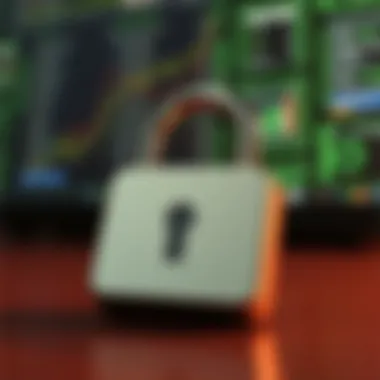Understanding Two-Factor Authentication in Security


Intro
In today's tech-savvy world, where our digital identities often hold as much value as our physical selves, safeguarding these identities has become paramount. Relying solely on passwords is as antiquated as using a horse and buggy in an era of electric cars. As cyber threats become more sophisticated, the need for enhanced security measures grows stronger. One of the most effective methods to bolster security is Two-Factor Authentication, commonly known as 2FA.
This approach requires users to provide not just one, but two distinct forms of verification before accessing their accounts. The two factors typically fall into three categories: something you know (like a password), something you have (such as a smartphone), and something you are (like a fingerprint). By incorporating an additional layer of verification, 2FA significantly reduces the risk of unauthorized access to sensitive information.
Understanding 2FA is crucial for everyone—from the casual social media user to the IT professional managing sensitive corporate data. In this article, we will explore the importance of Two-Factor Authentication, discuss its various implementation methods, weigh its benefits against its limitations, and highlight best practices to follow. We will also take a peek into future developments in authentication technology, ensuring you are well-prepared to navigate the continuously evolving landscape of digital security.
Understanding Two-Factor Authentication
In a world where data breaches and cyber threats are increasingly common, understanding Two-Factor Authentication (2FA) has become essential for both individuals and organizations. 2FA stands as a formidable barrier against unauthorized access, fortifying security by adding a layer of verification. Its importance can’t be overstated, as it plays a pivotal role in safeguarding sensitive information and ensuring that users maintain control over their digital lives.
Definition of Two-Factor Authentication
Two-Factor Authentication is a security technique that requires two different types of verification for a user to gain access to an account. Essentially, instead of simply entering a password, the user must also provide another piece of information. This can vary from a code sent to their mobile device to a fingerprint scan. The dual requirement significantly enhances security since even if a password is compromised, the additional factor serves as a protective measure against unauthorized use.
Historical Context of Authentication Methods
Authentication has historically evolved from basic methods such as passwords to more sophisticated requirements. Early systems primarily relied on what the user knew, typically a single password. Over time, the limitations of this approach became evident, particularly as hacking techniques advanced. In response, more rigorous methods were developed, reflecting a growing understanding that security must integrate multiple factors to be effective. 2FA emerged from the necessity to execute this foundational change, ushering in a new era of digital security.
Types of Authentication Factors
To truly grasp 2FA, it’s crucial to familiarize oneself with the various types of authentication factors. Broadly speaking, these can be classified into three categories: Knowledge Factors, Possession Factors, and Inherence Factors.
Knowledge Factors
Knowledge Factors refer to elements that only the user should know, often manifested in the form of passwords or personal identification numbers (PINs). This factor's key characteristic is that it relies on the user’s memory or understanding. As it’s a well-established method, it remains popular; however, its widespread use has led to predictable vulnerabilities such as weak passwords. A unique aspect of Knowledge Factors is the ease of implementation, making it a practical choice for many systems. Yet, it has significant downsides as well, particularly if the stored information is not strong enough.
Possession Factors
Possession Factors hinge on items that the user possesses, like mobile devices or hardware tokens. Their key characteristic is the reliance on something tangible, which adds a layer of security since an intruder would need physical access to the item. These factors are beneficial in two main ways: they are often user-friendly while significantly raising security standards. However, challenges such as losing the possession factor, like a phone or a token, can cause difficulties during the authentication process. Additionally, the risk of theft magnifies if these items are not adequately protected.
Inherence Factors
Inherence Factors are based around the user’s physical traits, predominantly biometrics, such as fingerprints or facial recognition. This characteristic stands out because it ties the authentication process directly to the individual, ensuring that only they can gain access. The automatic nature of this method is a key advantage since it minimizes user input, making operations smooth and quick. However, challenges arise with technology limitations and privacy concerns over biometric data storage, inciting a discussion about ethical implications in security.
Understanding these factors is vital for effectively implementing Two-Factor Authentication. Each category presents unique advantages and drawbacks that can impact user security in today’s digital landscape.
How Two-Factor Authentication Works
In the digital age, where online threats are as common as morning coffee, understanding how Two-Factor Authentication (2FA) works is paramount. This process does wonders in bolstering security; it adds yet another layer of protection beyond just a password. Think about the last time you faced a problem with a reset password; 2FA can help avoid many of those headaches by ensuring that a person logging in is genuinely who they say they are.
Implementing 2FA is not merely about keeping cybercriminals at bay; it’s about assuring users that their data is secure. The core mechanism entails requiring two distinct forms of identification. It’s like asking for not just the keys to a car, but also a fingerprint. This two-step process greatly diminishes the chances of unauthorized access.
The realm of online interactions is fraught with risks. With rising incidents of data breaches, companies and users must opt for more robust security measures. Implementing 2FA mitigates some of those fears, instilling a sense of confidence in users while unlocking their accounts or making sensitive transactions.
The Process of 2FA Implementation
Setting up Two-Factor Authentication, while straightforward, requires careful attention to detail. Users typically follow these main steps:
- Choose an Authentication Method: Users decide which two forms of identification they’d like to use. This may involve an SMS code or a specific app.
- Enable 2FA in Account Settings: Once the user logs into their account, they can usually find the option to enable this feature in the settings menu.
- Verify Current Details: The user must confirm the primary authentication means (e.g., password) before adding the second factor.
- Testing the Setup: After configuration, the user should test the process to ensure both factors are working smoothly.
- Backup Options: It’s wise to set up recovery options in case they lose access to the second factor, ensuring they don't find themselves stuck.
This step-by-step approach reinforces the notion that implementing 2FA is an investment in users' security, encouraging them to be proactive when protecting their sensitive information.
Common Technologies Used in 2FA
Two-Factor Authentication can be implemented through various technologies, each with its unique benefits and challenges. Let’s dive into a few popular methods:
SMS and Email Verification
SMS and Email Verification serves as perhaps the most traditional form of two-factor authentication. When a user loginto their account, they receive a time-sensitive code via SMS or email.
- Key Characteristic: The ease of access. Almost everyone has a mobile phone or email account these days.
- Benefits: Instant delivery of verification codes makes it a quick option for users. Most people find this method familiar and user-friendly.
- Drawbacks: However, SMS messages can sometimes be intercepted, making this method less secure than one would hope. Phishing attacks often target email, which can lead to compromised accounts if users aren't vigilant.
Authenticator Apps
Authenticator Apps like Google Authenticator or Authy allow users to generate a verification code directly from their devices. This adds an element of security that is increasingly popular.
- Key Characteristic: Codes are generated based on time and are not sent across the network, reducing interception risk.
- Benefits: They typically offer better security compared to SMS, as it's harder for attackers to gain access to the app without the device itself.
- Drawbacks: Users need to install an app and might find it inconvenient or confusing at first, especially those not well-acquainted with technology.


Hardware Tokens
Hardware Tokens are physical devices, essentially small gadgets that generate a new code at regular intervals. They are favored in high-security environments, such as banks.
- Key Characteristic: Tangibility. Unlike software solutions, these tokens are distinct, separate devices.
- Benefits: They offer an added layer of security since they are not connected to the internet. This significantly reduces the risk of remote hacking.
- Drawbacks: They can be costly and inconvenient. If a user loses their token, recovering access can become a drawn-out ordeal.
Each of these technologies brings something unique to the table. Deciding the right one depends heavily on user needs, preferences, and the level of security required.
"In today's digital world, relying only on a password is akin to leaving your front door wide open on a stormy night."
For more information on security implementations, explore resources such as Wikipedia or the U.S. Department of Homeland Security.
In summary, understanding how Two-Factor Authentication works, the methods available, and the pros and cons of each gives users the tools they need to enhance their online security effectively.
Advantages of Two-Factor Authentication
Two-Factor Authentication (2FA) has become a linchpin in the contemporary security landscape. It plays a pivotal role in safeguarding data against a multitude of threats that can compromise personal and organizational information. Let's explore
Increased Security for Personal Accounts
One of the primary advantages of implementing 2FA is the remarkable enhancement it brings to personal account security. In the digital age, breaching personal accounts has grown alarmingly simple for experienced cybercriminals. Utilizing only passwords can be likened to locking the front door with a flimsy latch; it may deter the casual passerby but is hardly effective against someone determined to break in. 2FA adds a second layer to this door, making it far more resilient.
For instance, when integrating 2FA, a user logs into their email or social media account, not only entering their password but also providing a verification code sent to their mobile device. This dual requirement makes unauthorized access exceedingly difficult. Furthermore, research states that accounts secured by 2FA are 99.9% less likely to be hacked compared to those without it.
Reduction in Unauthorized Access
Another critical benefit of 2FA is the tangible reduction it offers in unauthorized access attempts. With the epidemic of identity theft and credential stuffing attacks, the need for more robust authentication measures is paramount.
Consider this: many users opt for similar or identical passwords across multiple accounts, creating a treasure trove for hackers. If one password is leaked, they can easily infiltrate various accounts. 2FA to the rescue! Even if an attacker manages to snag a password, they would still need access to the second factor. This drastically cuts down the chances of unauthorized data breaches, making it significantly more challenging for hackers to exploit compromised credentials. As the saying goes, *
Limitations of Two-Factor Authentication
While Two-Factor Authentication (2FA) has proven to be a robust mechanism for enhancing digital security, it is not without its drawbacks. Understanding these limitations is crucial for users and organizations alike. Identifying and addressing potential weaknesses can help create a more comprehensive strategy for safeguarding sensitive information. Let's dive deeper into some specific aspects that can hinder the effectiveness of 2FA.
User Resistance to Additional Steps
One of the most significant hurdles in the adoption of Two-Factor Authentication is user resistance. Many people naturally gravitate towards convenience; after all, who wants to go through extra steps when logging into an account, right? This mentality often leads to a reluctance to embrace 2FA, as users might view it as an inconvenience rather than an added layer of security.
The perception of 2FA as a hassle can result in lower adoption rates. For instance, a user might find it too cumbersome to reach for their phone for an SMS code or to open an authenticator app every time they need to log in. This can be especially true for users who are not technologically savvy. Thus, striking a balance between security measures and usability is essential.
Potential for Technical Issues
Technical difficulties are another area where Two-Factor Authentication can falter. Such issues often arise from connectivity problems or server downtimes, both of which can obstruct access to accounts that require 2FA.
Connectivity Issues
Connectivity issues can crop up unexpectedly, impacting the ability of users to receive authentication codes in a timely manner. Imagine trying to log in to your bank account only to find that your mobile network is down. It's not just a minor annoyance; it could hinder access to critical financial information, thereby impacting user trust.
In scenarios where users rely on SMS for authentication, network errors can lead to significant delays or even complete failures in code delivery. This contributes to frustration and can lead to negative experiences, reducing overall satisfaction with security protocols.
Server Downtime
Server downtime presents another technical challenge that can disable Two-Factor Authentication systems. When service providers experience outages, users may find themselves locked out of accounts that utilize 2FA, regardless of whether they have correctly entered their secondary verification method.
Such interruptions might be temporary, yet they can leave a lasting impression, especially if users feel they can’t rely on their security measures when they need them the most. Furthermore, downtime can give attackers a window of opportunity to exploit other vulnerabilities while the 2FA system is compromised.
Vulnerabilities in Certain Methods
Despite the general effectiveness of Two-Factor Authentication, certain methods may hold inherent vulnerabilities. Potential threats like SIM swapping and phishing attacks are critical considerations when evaluating different 2FA techniques.
SIM Swapping
SIM swapping is a technique where attackers convince mobile carriers to transfer a victim’s phone number to a SIM card they control. This act can allow them access to text messages, making it easier to intercept verification codes sent via SMS.
While SIM swapping represents a low-frequency risk, the impact can be severe, leading to unauthorized access to accounts and ultimately financial loss. In the world of digital security, open vulnerabilities like this require constant vigilance and proactive measures.
Phishing Attacks
Phishing remains a popular tactic that many cybercriminals still effectively employ. Attackers create fake sites that mimic legitimate ones, tricking users into entering their credentials, including the second factor for authentication. For instance, a user might unknowingly enter their Google verification code on a malicious site, thus granting hackers access to their accounts.


The key characteristic of phishing is that it exploits human trust. Without careful education and awareness, users can fall victim to these elaborate schemes, rendering even the most elaborate 2FA methods ineffective.
End
Understanding the limitations of Two-Factor Authentication is as vital as acknowledging its advantages. User resistance, technical issues, and vulnerabilities in certain methods highlight that while 2FA significantly enhances security, it is essential to be mindful of the challenges that accompany it. Organizations and individuals should establish comprehensive strategies that account for these limitations, ensuring a more secure digital environment.
Implementing Two-Factor Authentication
The topic of implementing Two-Factor Authentication (2FA) holds particular significance in today’s world, where cyber threats loom large over our digital lives. The simple act of requiring two forms of verification can serve as a powerful defense against unauthorized access to sensitive information. Implementing 2FA not only protects personal accounts but also strengthens security protocols within organizations.
A shift in behavior is often required from users and organizations alike. For individuals, enabling 2FA isn't just about ticking a box on a security checklist; it’s about understanding the landscape of risks they face online. Organizations, on the other hand, must embrace a mindset that acknowledges these risks and actively works to mitigate them through robust security measures.
Steps for Users to Enable 2FA
Turning on Two-Factor Authentication might seem daunting to some users, but breaking it down into actionable steps can simplify the process. Here’s how a user can enable 2FA on most platforms:
- Log into Your Account: Start by logging into the account you wish to secure.
- Navigate to Security Settings: Go to the settings or account options, often found in the profile menu.
- Find Two-Factor Authentication: Look for options labeled "Two-Step Verification," "Two-Factor Authentication," or something similar.
- Select Preferred Method: Choose whether you want to receive codes via SMS, through an app like Google Authenticator, or using hardware tokens.
- Follow the Prompts: After selecting your method, follow any prompts to complete the setup. This often includes verifying the method chosen.
By taking these straightforward steps, users can significantly bolster their account security.
Best Practices for Organizations
Implementing Two-Factor Authentication (2FA) in organizations requires careful planning and strategy. A few best practices can ensure an effective roll-out.
Choosing the Right Authentication Methods
When it comes to Choosing the Right Authentication Methods, organizations need to weigh various factors to find what fits best for their needs. Understanding user behavior is crucial here. Some users may prefer hardware tokens, which can offer heightened security but might come with additional costs and administrative burdens. Others might favor mobile apps for their convenience.
It’s also essential to consider the threat landscape. Organizations in sectors like finance will find the need for more stringent authentication measures due to higher stakes concerning breaches. Selecting methods that align with the organization's risk profile is vital. This choice provides a substantial layer of protection, contributing to overall security success.
Training Employees on 2FA Policies
Another cornerstone of effective 2FA implementation is Training Employees on 2FA Policies. While technology can handle many security measures, people remain the most unpredictable variable. Educating employees about the importance of 2FA and how to use it correctly ensures they play a proactive role in maintaining organizational security.
A key characteristic of this training should involve practical sessions where employees engage with the system directly. This hands-on approach helps demystify the process and reassures them that adopting 2FA isn’t a hassle, but instead a necessary safeguard.
It is equally important to create an open line of communication so that employees feel comfortable reporting difficulties or potential issues. When each employee understands their role in maintaining security, the risk of breaches decreases significantly.
In summary, both choosing the right methods and training employees effectively are crucial components that contribute to the overarching goal of enhancing security through 2FA implementation. Staying ahead of security threats not only protects data but also fosters trust in the organization as a whole.
"Security is not a product, but a process." - Bruce Schneier
By taking these steps, organizations can better secure their information and help create a culture of cybersecurity awareness.
Future of Authentication Technologies
The landscape of digital security is ever-evolving. Two-Factor Authentication (2FA) stands at the forefront of these changes, often seen as a necessary bulwark against unauthorized access. As we direct our gaze towards the future of authentication technologies, several key dynamics emerge that shape our understanding and implementation of security measures. Adapting to these changes isn't just about staying current; it is pivotal to safeguarding digital identities in a progressively complex web of threats.
Emerging Trends in Security Technologies
In the realm of security, staying ahead is crucial. Emerging trends reflect shifts not only in technology but in the way users interact with it. The rise of artificial intelligence (AI) in security is noteworthy. AI algorithms can analyze user behavior, flagging anomalies that could suggest security breaches. Additionally, machine learning technologies improve security systems rapidly, making them smarter over time.
Moreover, the Internet of Things (IoT) brings about a need for integration. Devices connected to the internet widen the attack surface for cyber threats. As such, innovative approaches like device behavior analytics are gaining traction. Each device’s specific behavior is monitored, enhancing the capacity to catch hijackers before they can do any harm.
- User-centric security is also gaining traction, which emphasizes a design that puts the user at the center of security protocols—making them safer while navigating online.
- Another trend is the shift towards passwordless authentication. This method relies on alternatives such as biometrics or hardware tokens, minimizing risks associated with stolen or weak passwords.
The Role of Biometric Authentication
Biometric authentication is gradually reshaping the narrative around digital security. It utilizes unique physical or behavioral characteristics—think fingerprints, facial recognition, or voice patterns—to verify identity. This form of authentication transcends traditional methods, often proving to be more reliable and less susceptible to fraud.
In practical terms, employing biometrics can lead to a more seamless user experience. For instance, users won’t have to remember complex passwords or resolve lockout issues. Instead, a quick thumbprint can unlock their device or authorize a transaction. However, while biometric systems hold promise, they also raise ethical questions surrounding privacy, data management, and the potential for misuse.
Adopting biometric technologies requires a thoughtful approach to address:
- User consent: Transparency about how data is collected and used is paramount.
- Data security: Measures must be in place to protect biometric data from breaches, as these identifiers are essentially irreplaceable.
Potential Developments in 2FA
As technology continues to advance, the approach to Two-Factor Authentication is also anticipated to evolve. Future development will likely focus on enhancing user experience while strengthening security protocols. Some potential developments are worth exploring:


- Adaptive authentication: This concept tailors the security measures based on context, such as the user's location or the device being used. A transaction might require different factors if the request comes from an unusual geographic location.
- Integration with wearables: Devices like smartwatches may provide another layer of verification. Users could receive confirmations directly on their wrist, making the authentication process quicker and more integrated into everyday life.
"The landscape of digital security is ever-evolving, and adapting is vital not just for safety but for retained trust in online platforms."
- Decentralized identity systems: These could promise increased ownership of personal data, putting control back into users' hands and limiting reliance on a single provider to manage identity credentials.
The trajectory towards these future methodologies indicates a blend of enhanced security, user experience considerations, and ethical considerations as essential elements in developing authentication technologies.
Case Studies of 2FA Implementation
Case studies provide a nuanced understanding of how two-factor authentication (2FA) can be practically applied across various sectors. They reveal the methods employed, the challenges encountered during the implementation, and the overall impact on security posture. These examples also demonstrate the tangible benefits of investing time and resources in 2FA solutions, a crucial consideration for both individuals and organizations.
Successful Implementation in Financial Institutions
Historically, financial institutions have been terra firma for the adoption of stringent security measures, mainly due to the sensitive nature of the data they handle. Let’s consider a notable example: JP Morgan Chase. The bank faced an alarming increase in cyberattacks and data breaches, prompting them to enforce a robust 2FA system for their online banking users. The structure involved requiring users to input a password along with a code sent to their registered mobile devices.
The result? A staggering drop in unauthorized access attempts, as the additional verification step acted as a formidable barrier for cybercriminals. Moreover, customers reported a heightened sense of security, understanding that their accounts were now fortified against common threats. This integration positively impacted customer trust, showing that a well-implemented 2FA system not only boosts security but also solidifies the customer relationship.
Key Lessons Learned from JP Morgan Chase:
- User Education is Essential: Continuous communication about the importance of 2FA encouraged users to embrace the change without resistance.
- Customized Solutions: Financial institutions should tailor their 2FA solutions to account for different user needs and technological comfort levels.
2FA in E-commerce Platforms
E-commerce platforms also illustrate a significant case for 2FA application. Take Amazon, for example. As one of the largest online retailers, they recognized the increasing risk of account takeovers where malicious actors could compromise accounts and wreak havoc on transactions. To address this, Amazon instituted two-factor authentication for its users.
When a user logs in from an unrecognized device, they are prompted to receive a text message or email with a code for verification. This added layer fundamentally changes the dynamics of online shopping, reducing fraudulent activities significantly. It not only protected direct financial transactions but also safeguarded sensitive personal information stored in customer profiles.
Takeaways from Amazon's Implementation:
- Balancing Security and User Experience: While adding more steps can deter criminals, the balance must not come at the cost of user convenience.
- Real-time Alerts: Prompting users to recognize unusual login attempts also serves as an effective deterrent against unauthorized access.
With the rise of cyber threats, implementing 2FA through well-documented case studies in sectors like finance and e-commerce showcases clear benefits. These examples solidify the narrative that while 2FA might introduce a minor inconvenience, the enhanced security it provides is well worth it.
"In the midst of chaos, there is also opportunity." – Sun Tzu
The Impact of 2FA on User Behavior
Two-Factor Authentication (2FA) has transformed the landscape of digital security significantly, influencing how users perceive and engage with online services. Understanding this impact on user behavior is crucial for grasping the broader significance of 2FA in safeguarding information. It offers a synthesis between technology and human response that is both fascinating and vital for ongoing discussions in cybersecurity.
Change in Perception of Security
With the introduction of 2FA, users begin to view security with a keener eye. Before its widespread adoption, many individuals likely thought that a strong password was sufficient. However, as breaches became more common, awareness grew. People started to understand that passwords could be compromised, leading to the necessity for additional layers of protection.
- Increased Vigilance: Users are now more cautious about sharing personal information. They often question the security measures of websites before engaging. This heightened awareness is crucial in today's digital age where breaches can occur frequently.
- Confidence in Using Services: As users implement 2FA and find it effective, their confidence in utilizing online services grows. They no longer shy away from e-commerce transactions or sensitive communications, knowing that an extra layer of security exists.
"Security is not a product, but a process," often quoted, reflects how 2FA has become a critical part of that ongoing process for many individuals.
User Adaptation and Compliance
Adapting to new processes can be challenging, yet 2FA's integration has evoked varying levels of compliance among users. While some individuals have embraced this security upgrade, others exhibit resistance. Here are several factors influencing user adaptation:
- User Experience: The smoother the implementation process, the higher the likelihood of adoption. Applications that allow for seamless integration of 2FA often report better user compliance.
- Education and Awareness: When organizations inform users about the importance and mechanics of 2FA, they foster a culture of security. Users become more willing to engage with security measures that they understand and trust.
- Incentives: Offering incentives to users who opt for 2FA, such as discounts or access to premium features, can also promote compliance. This method emphasizes the reciprocal nature of user privacy and service enhancement.
- Feedback Mechanism: Platforms that actively seek user feedback about their experience with 2FA can adapt their strategies, ensuring user engagement is maintained. Listening to user experiences helps organizations enhance this process continuously.
Ending
In the expanse of digital security, the adoption ofTwo-Factor Authentication (2FA) stands out as a pivotal measure for safeguarding personal and organizational data. As threats evolve and the frequency of cyber attacks escalates, implementing 2FA is no longer a luxury but a necessity. This article emphasizes its critical role in offering an additional layer of protection beyond mere passwords.
Summary of Key Points
Two-Factor Authentication enhances security through a systematic approach:
- Increased Security: By requiring two distinct forms of verification, 2FA greatly decreases the likelihood of unauthorized access. This multifaceted approach significantly bolsters defenses against common attacks, such as phishing and credential theft.
- User Compliance and Awareness: Individuals are more inclined to adopt 2FA solutions when organizations prioritize user education. As users understand the strengths of enhanced security measures, compliance increases alongside their awareness of cybersecurity threats.
- Scalability for Organizations: Businesses can implement tailored 2FA solutions that suit different operational levels, thereby manifesting a versatile approach in securing sensitive data. Various factors such as user role, transaction type, and device security can dictate which 2FA method works best.
- Future Viability of Security Strategies: As emerging technologies integrate into daily use, two-factor authentication remains adaptable and effective when combined with promising trends like biometrics and machine learning systems. Keeping pace with advances ensures that security measures are not just reactive but predictive as well.
The landscape of online security is continually shifting; safeguarding data with 2FA can mean the difference between safety and susceptibility in our increasingly connected world.
Final Thoughts on the Necessity of 2FA
As the digital age marches forward, complacency cannot be afforded. Users must recognize the profound impact that Two-Factor Authentication has on their security practices. The threats we face are real and can be detrimental, not only on an individual basis but also at a corporate level where breaches can lead to debilitating financial loss and diminished trust.
Two-Factor Authentication is not just a trend but a fundamental security tenet that warrants unabated adoption across the landscape. Organizations must cultivate this practice, instilling in their staff a culture of vigilance. The simplicity of adding another layer of authentication pales in comparison to the complexities associated with recovery from a data breach.
Overall, the era of taking shortcuts in online security must end. Instead of viewing 2FA as an inconvenience, it should be embraced as a vital guard against cultural and financial threats we face in our interconnected lives. Balancing usability with upholding security principles is no easy task, but it is one that pays dividends in user confidence and protection longevity.
For more on security best practices, you can visit U.S. Cybersecurity & Infrastructure Security Agency or check resources on Wikipedia for further insights.



